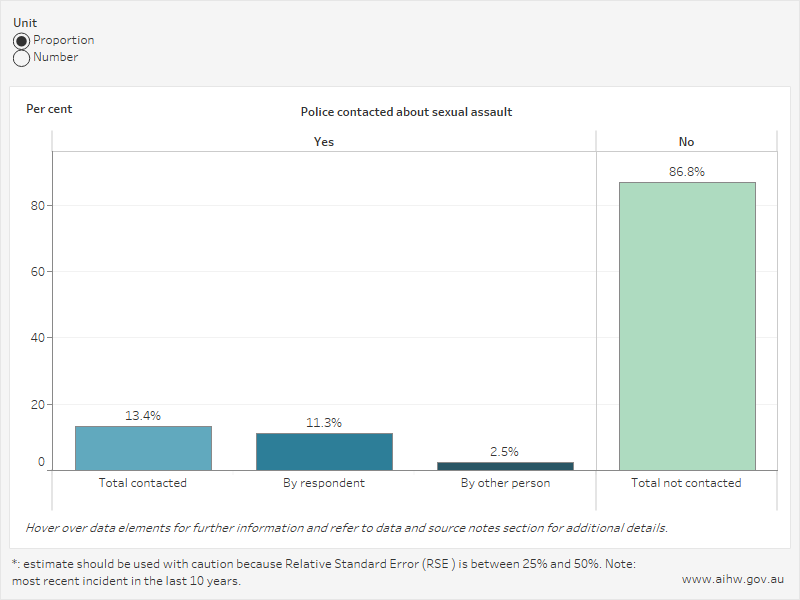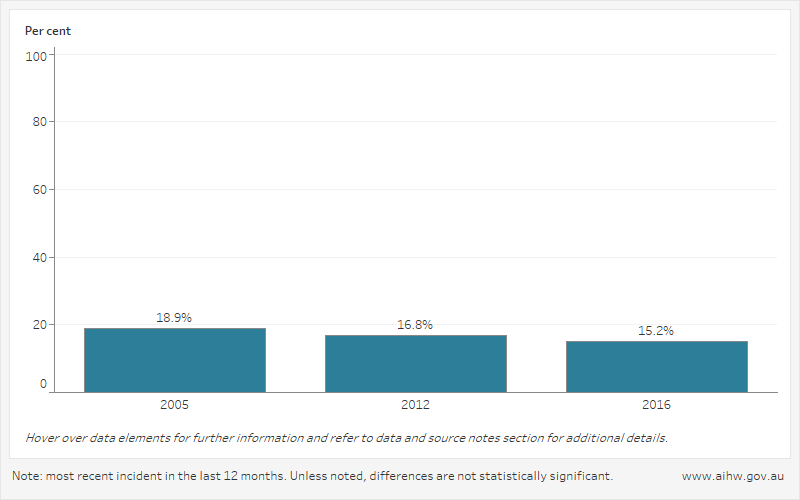Sexual assault reported to police
Sexual assault may be reported to police. Examining whether police are contacted following sexual assault can provide an indication of reporting levels and utilisation of police services. Data on whether police were contacted (by the victim or another person) after sexual assault, as well as reasons for not contacting, are available from the ABS Personal Safety Survey (PSS). The PSS collects information on the experiences of violence for women and men in Australia.
The visualisation below shows whether a female respondent’s most recent incident of sexual assault by a male in the last 10 years was reported to police. In 2016, the police were not contacted in around 7 in 8 (or 87%) of these incidents. Data for male victims are not available due to data quality issues.
Police contacted after most recent sexual assault by a male perpetrator, females, 2016

Source data: Sexual assault reported to police tables (58KB XLSX)
Time Series
Examining reporting to police over time can provide insight into whether the reporting of sexual assaults is changing.
The visualisation below shows whether female respondent’s most recent incident of sexual assault by a male in the last 12 months was reported to police, over time. Between 2005 and 2016, the proportion of incidents the police were contacted about remained relatively stable.
Police contacted after most recent incident of sexual assault by a male perpetrator in the last 12 months, females, 2005, 2012 and 2016

Source data: Sexual assault reported to police tables (58KB XLSX)
Examining reasons why people choose not to contact police after a sexual assault can provide insight into how victims can be better supported and encouraged to seek help.
The visualisation below shows the reasons why women did not contact police following their most recent incident of sexual assault by a male in the last 10 years. The two most common reasons police were not contacted were because victims ‘Felt like they could deal with it themselves’ and/or they ‘Did not regard the incident as a serious offence’. Data for male victims are not available due to data quality issues.
Reasons police not contacted after most recent incident of sexual assault by a male perpetrator, females, 2016
Source data: Sexual assault reported to police tables (58KB XLSX)
Notes
- The PSS defines sexual assault as an act of a sexual nature carried out against a person's will through the use of physical force, intimidation or coercion, including any attempts to do this. This includes rape, attempted rape, aggravated sexual assault (assault with a weapon), indecent assault, penetration by objects, forced sexual activity that did not end in penetration and attempts to force a person into sexual activity. Incidents so defined would be an offence under State and Territory criminal law.
- Whether police were contacted was open to the respondent’s interpretation, and may include both contact that did and did not amount to a formal report.
- If a respondent did not contact the police, but the police ‘happened to attend’, this was recorded as someone else contacting the police. If the incident occurred in a public place such as a shopping centre, and security was contacted, this was recorded as the police not being contacted. However, if security subsequently contacted the police then it was recorded as someone else contacting the police.
- Unless otherwise stated, most recent incident is limited to the last 10 years only.
- Annual estimates and proportion of persons aged 15 years and over who reported their most recent incident of sexual assault to police are included in ABS Crime Victimisation, Australia (see table 5a–5d).
- The PSS collects information from women and men aged 18 years and over.
-
The observed value of a rate may vary due to chance even where there is no variation in the underlying value of the rate. The margin of error is the largest possible difference (due to sampling error) that could exist between the estimate and what would have been produced had all persons been included in the survey. Confidence intervals—constructed by taking the estimate plus or minus the MoE— can be used to provide an approximate indication of the true differences between rates. If the confidence intervals do not overlap, the difference can be said to be statistically significant. However, statistically significant differences are not necessarily the same as differences considered to be of practical importance. Small differences that have practical importance may be found to be not statistically significant as they are below the threshold the significance test can reliably detect.
-
For more information see Methods, Glossary and Data sources.
Sources
ABS 2016 Personal Safety Survey
Next expected: 2022


